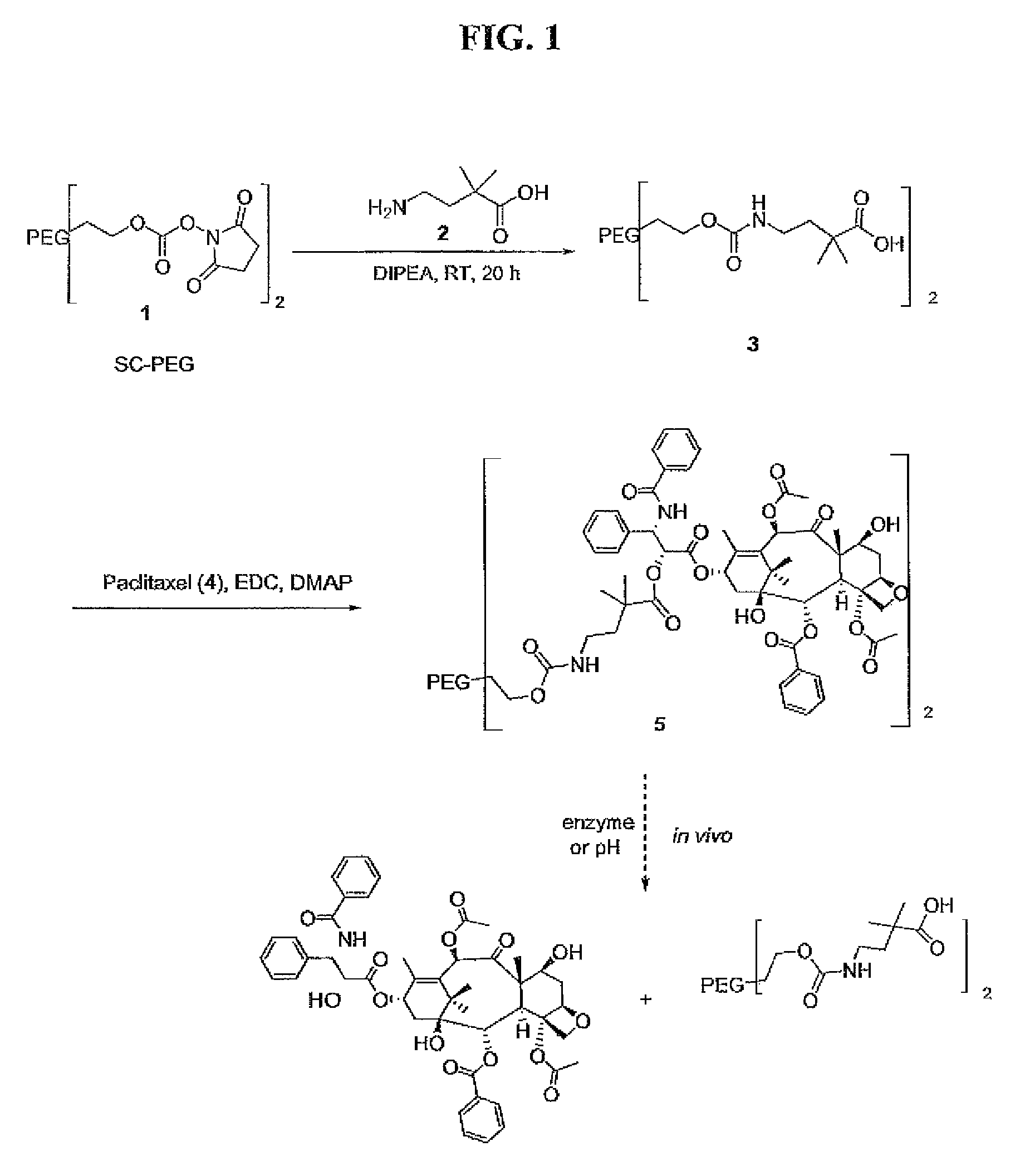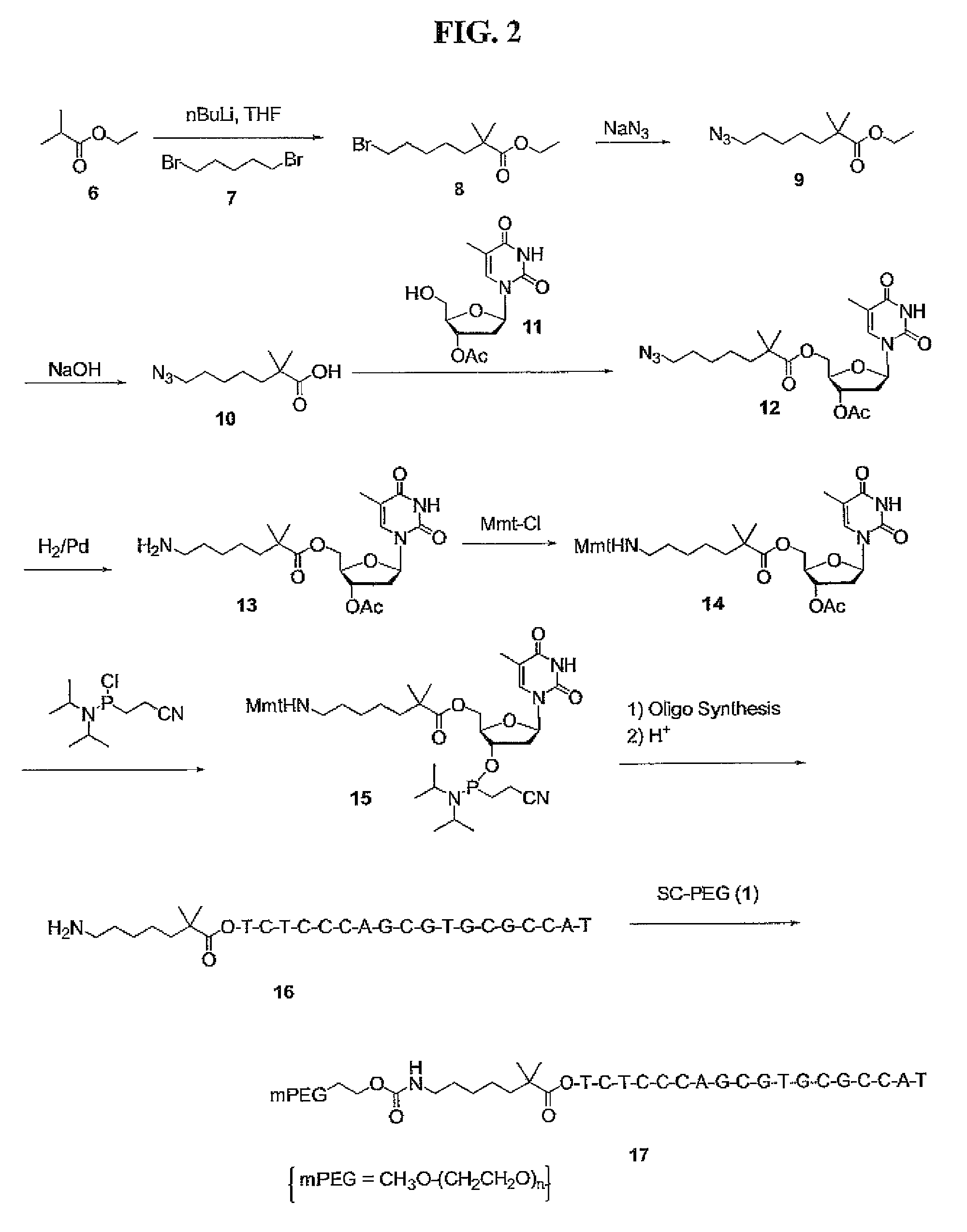Polyalkylene oxides having hindered ester-based biodegradable linkers
a technology of polyalkylene oxide and ester, which is applied in the field of polyalkylene oxides with hinds, can solve the problems of unsuitable in vivo use of antisense oligonucleotides, increase toxicity, and unmodified antisense oligonucleotides, and achieve the effects of reducing the number of diastereomers, increasing the toxicity, and increasing the toxicity
- Summary
- Abstract
- Description
- Claims
- Application Information
AI Technical Summary
Benefits of technology
Problems solved by technology
Method used
Image
Examples
example 1
Preparation of PEG-HE-Acid, Compound (3)
[0244]SC-PEG (compound 1, Mw. 40 kDa, 1.5 g, 0.0375 mmol) was dissolved in DCM (20 mL) at room temperature. To the solution, 4-amino-2,2-dimethylbutyric acid hydrochloride (compound 2, 26.4 mg, 0.158 mmol), diisopropylethyl amine (40 μL, 0.225 mmol) and DMF (1 mL) were added. Reaction mixture was stirred for 20 hours at room temperature and solvent was partially removed in vacuo. Residue was precipitated by adding ether (40 mL) to give a white solid which was recrystallized from acetonitrile-IPA to obtain 1.35 g of product: 13C NMR δ 178.5, 156.5, 70.6, 63.9, 40.3, 40.2, 25.6.
example 2
Preparation of PEG-HE-Paclitaxel, Compound (5)
[0245]Compound 3 (1.3 g, 0.0322 mmol) was dissolved in a mixture of chloroform (20 mL) and DMF (6 mL). To the stirred solution was added paclitaxel (compound 4, 0.165 g, 0.1932 mmol) followed by DMAP (51 mg, 0.420 mmol) at room temperature. The reaction mixture was then cooled at −8° C., and EDC (50 mg, 0.258 mmol) was added. The reaction mixture was allowed to warm up to room temperature and stirred for 20 hours. Solvents including DMF were removed on rotary evaporator water bath temperature not exceeding 37° C. To the remaining residue was added ether to obtain a solid which was recrystallized from acetonitrile-IPA: 13C NMR δ 204, 177, 174, 172, 171, 170, 167, 127-134 (7 signals), 63.8, 58.5, 55.0, 36-46 (6 signals), 9.5-28 (8 signals).
example 3
Preparation of Br—HE-OEt, Compound (8)
[0246]Butyllithium (1.6 M solution in t-BuOH, 200 ml) was added to a solution of ethyl isobutyrate (compound 6, 35 g) in F (500 mL) at −78° C. and the solution was stirred for 1 h at the same temperature. 1,5-Dibromopetane (compound 7, 100 g) was added and the mixture was allowed to warm up to room temperature. The mire was stirred at room temperature for 1 hour and was poured into aqueous sodium bicarbonate (500 mL). The organic layer was evaporated. The residue was purified by a silica gel column, eluted with 10% ethyl acetate in hexane to give the desired product as a liquid (29.2 g, yield 36.7%).
PUM
| Property | Measurement | Unit |
|---|---|---|
| average molecular weight | aaaaa | aaaaa |
| average molecular weight | aaaaa | aaaaa |
| average molecular weight | aaaaa | aaaaa |
Abstract
Description
Claims
Application Information
 Login to View More
Login to View More - R&D
- Intellectual Property
- Life Sciences
- Materials
- Tech Scout
- Unparalleled Data Quality
- Higher Quality Content
- 60% Fewer Hallucinations
Browse by: Latest US Patents, China's latest patents, Technical Efficacy Thesaurus, Application Domain, Technology Topic, Popular Technical Reports.
© 2025 PatSnap. All rights reserved.Legal|Privacy policy|Modern Slavery Act Transparency Statement|Sitemap|About US| Contact US: help@patsnap.com



